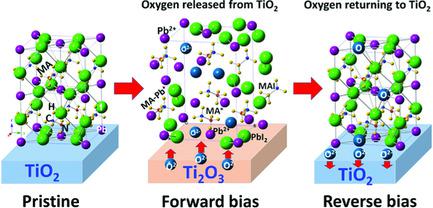当前位置:
X-MOL 学术
›
Adv. Mater.
›
论文详情
Our official English website, www.x-mol.net, welcomes your
feedback! (Note: you will need to create a separate account there.)
Stability of Halide Perovskite Solar Cell Devices: In Situ Observation of Oxygen Diffusion under Biasing
Advanced Materials ( IF 27.4 ) Pub Date : 2018-08-21 , DOI: 10.1002/adma.201802769
Hee Joon Jung 1, 2, 3 , Daehan Kim 4 , Sungkyu Kim 1, 3 , Joonsuk Park 5 , Vinayak P. Dravid 1, 2, 3 , Byungha Shin 4
Advanced Materials ( IF 27.4 ) Pub Date : 2018-08-21 , DOI: 10.1002/adma.201802769
Hee Joon Jung 1, 2, 3 , Daehan Kim 4 , Sungkyu Kim 1, 3 , Joonsuk Park 5 , Vinayak P. Dravid 1, 2, 3 , Byungha Shin 4
Affiliation

|
Using in situ electrical biasing transmission electron microscopy, structural and chemical modification to n–i–p‐type MAPbI3 solar cells are examined with a TiO2 electron‐transporting layer caused by bias in the absence of other stimuli known to affect the physical integrity of MAPbI3 such as moisture, oxygen, light, and thermal stress. Electron energy loss spectroscopy (EELS) measurements reveal that oxygen ions are released from the TiO2 and migrate into the MAPbI3 under a forward bias. The injection of oxygen is accompanied by significant structural transformation; a single‐crystalline MAPbI3 grain becomes amorphous with the appearance of PbI2. Withdrawal of oxygen back to the TiO2, and some restoration of the crystallinity of the MAPbI3, is observed after the storage in dark under no bias. A subsequent application of a reverse bias further removes more oxygen ions from the MAPbI3. Light current–voltage measurements of perovskite solar cells exhibit poorer performance after elongated forward biasing; recovery of the performance, though not complete, is achieved by subsequently applying a negative bias. The results indicate negative impacts on the device performance caused by the oxygen migration to the MAPbI3 under a forward bias. This study identifies a new degradation mechanism intrinsic to n–i–p MAPbI3 devices with TiO2.
中文翻译:

卤化物钙钛矿太阳能电池装置的稳定性:偏压下氧气扩散的原位观察
使用原位电偏压透射电子显微镜,利用由TiO 2电子传输层造成的n–i–p型MAPbI 3太阳能电池的结构和化学修饰,在没有其他已知影响物理完整性的刺激的情况下,由偏压引起MAPbI 3如水分,氧气,光和热应力。电子能量损失谱(EELS)测量表明,氧离子从TiO 2中释放出来,并在正向偏压下迁移到MAPbI 3中。氧气的注入伴随着明显的结构转变。单晶MAPbI 3晶粒变得无定形对PBI的外观2。在无偏压下于黑暗中储存后,观察到氧气回吸到TiO 2中,并恢复了MAPbI 3的结晶度。随后施加反向偏压进一步从MAPbI 3中除去更多的氧离子。钙钛矿型太阳能电池的光电流-电压测量在长时间的正向偏置后表现出较差的性能。恢复性能(尽管不完全)是通过随后施加负偏差来实现的。结果表明,在正向偏压下,氧气迁移至MAPbI 3会对器件性能产生负面影响。这项研究确定了具有TiO 2的n–i–p MAPbI 3器件固有的新降解机理。
更新日期:2018-08-21
中文翻译:

卤化物钙钛矿太阳能电池装置的稳定性:偏压下氧气扩散的原位观察
使用原位电偏压透射电子显微镜,利用由TiO 2电子传输层造成的n–i–p型MAPbI 3太阳能电池的结构和化学修饰,在没有其他已知影响物理完整性的刺激的情况下,由偏压引起MAPbI 3如水分,氧气,光和热应力。电子能量损失谱(EELS)测量表明,氧离子从TiO 2中释放出来,并在正向偏压下迁移到MAPbI 3中。氧气的注入伴随着明显的结构转变。单晶MAPbI 3晶粒变得无定形对PBI的外观2。在无偏压下于黑暗中储存后,观察到氧气回吸到TiO 2中,并恢复了MAPbI 3的结晶度。随后施加反向偏压进一步从MAPbI 3中除去更多的氧离子。钙钛矿型太阳能电池的光电流-电压测量在长时间的正向偏置后表现出较差的性能。恢复性能(尽管不完全)是通过随后施加负偏差来实现的。结果表明,在正向偏压下,氧气迁移至MAPbI 3会对器件性能产生负面影响。这项研究确定了具有TiO 2的n–i–p MAPbI 3器件固有的新降解机理。

































 京公网安备 11010802027423号
京公网安备 11010802027423号